Coast-to-coast Wisconsin bike trip reveals state's beauty and variety
“Well, this is a little daunting,” said my wife as we rolled our bikes out of the garage behind our Bay View home. For the next five days, Sonja and I would be pedaling across Wisconsin with all our gear crammed into four red panniers, and no sag wagon, or support car, to carry extra luggage or rescue us in case of injury or rain.
So began my 2023 birthday ride, a tradition born when I decided, some 20 years ago, that I would spend every birthday on a bicycle for as long as I could turn the pedals. Some of our excursions have been one- or two-day jaunts on local trails, while others have been more ambitious multi-day rides, including the Ohio to Erie Trail across Ohio, the Erie Canalway across New York, and my favorite so far, the GAP/C&O Trail from Pittsburgh to Washington, DC.
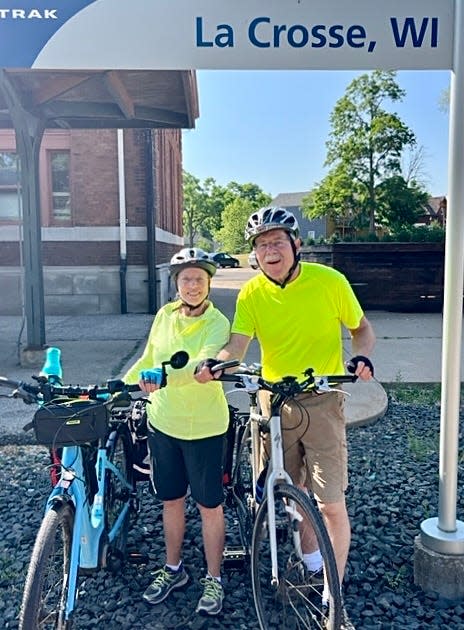
This trip, for my 76th birthday in early June, would be one of the longer ones: a coast-to-coast ride from the Mississippi River to Lake Michigan, covering what turned out to be 270 miles spread over five days. Amtrak made it possible. Our first destination after leaving Bay View was Milwaukee’s downtown train station, where we hoisted our bikes into the baggage car (for an extra $20 each) and boarded the Empire Builder to La Crosse. We spent almost the entire trip in the dome car, watching the Wisconsin landscape glide effortlessly by and realizing that we would be riding back under our own power the very next day. The train was like a diesel-powered chair lift, taking us to the top of our run and letting us choose the best route home.
Not that it was all downhill from La Crosse. Our journey included some of the hilliest sections of Wisconsin, but more than 70 percent of the ride was on dedicated state trails — some gravel, some blacktop, and nearly all former rail corridors engineered in the 1800s to be as level as possible. All were blissfully free of automobile traffic.
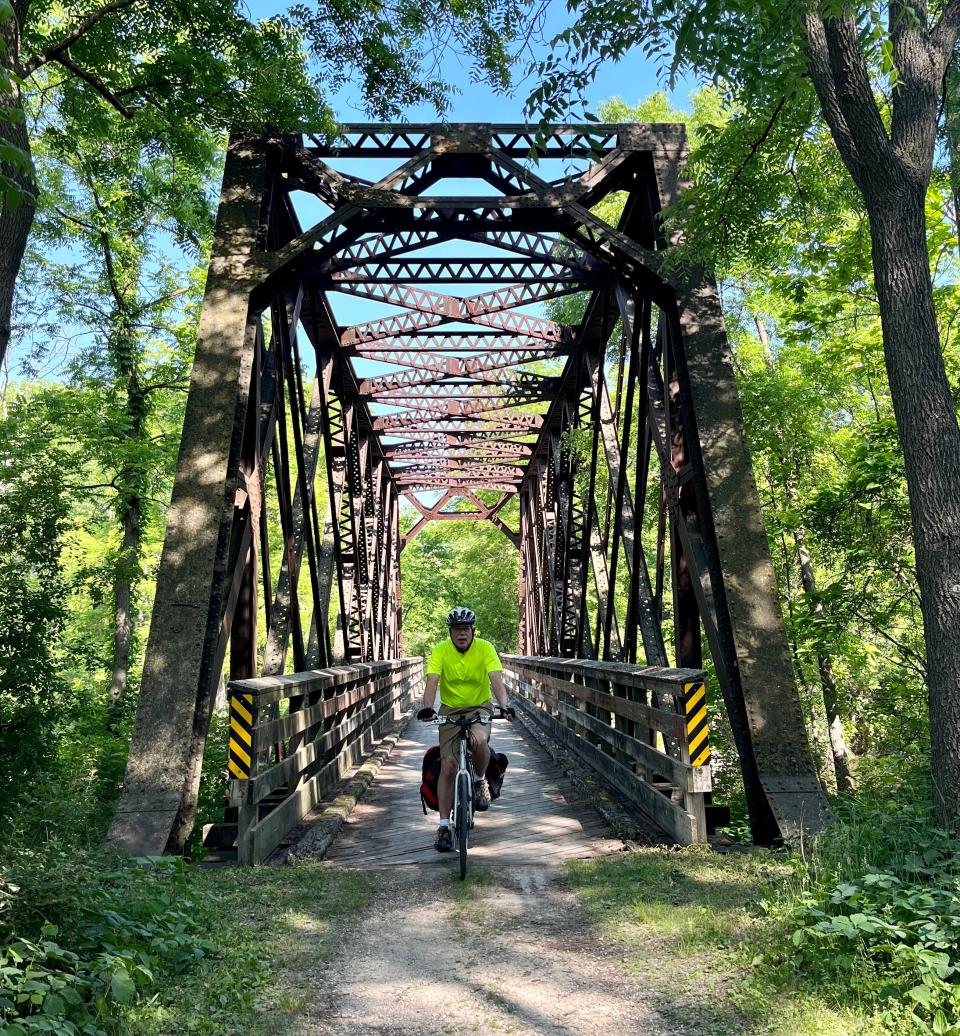
After spending the night in a riverside motel, we pedaled across a bridge over the freightyards of North La Crosse to start our journey. I was riding my old Specialized hybrid and Sonja her new Trek e-bike, which proved to be a great equalizer. After a few miles on the Great River Trail, we transitioned seamlessly to the La Crosse River Trail, which lies in a broad, flat valley that must have warmed the hearts of the railway’s builders in the 1870s. Freeway planners found the route just as irresistible. The trail parallels Interstate 90, which was seldom in sight but often within earshot.
I’ve driven that stretch of I-90 dozens of times, and the contrast between what you barely glimpse at freeway speed and what you experience on a bike was striking. Motorists rocketing by at 75 miles an hour wouldn’t have noticed the Amish farmer raking hay with his two-horse team or the vibrant orange-yellow flowers of hoary puccoon blooming in a trailside prairie. They couldn’t have heard the mixed chorus of birdsong in nesting season or enjoyed from yards away the smell of wild roses, a bold and complex fragrance that makes you realize how much was lost in breeding all those fussy hybrids. On a freeway, you make time, but that’s about all. On a bike trail, you take time and make memories.
At Sparta, the La Crosse Trail gave way, again seamlessly, to the celebrated Elroy-Sparta Trail. Opened in 1967, it was the first designated rail trail in America, and it’s still an all-star. Traversing the heart of the rugged Driftless Area, it tested the limits of its builders. They cut and filled, cut and filled, blasting small canyons through the high places and using the broken rock to level the low ones. Where the grade was simply too steep, they dug tunnels through the hills, three in all. The standout is Tunnel 3, closest to the Sparta end. At three-quarters of a mile, it’s the longest of the trio and also the wettest; it’s always raining in Number 3, the result of active springs in the bedrock above. The tunnel is a natural refrigerator as well. The temperature dropped from 80 degrees to about 50 soon after we entered; June became October in just a few yards.
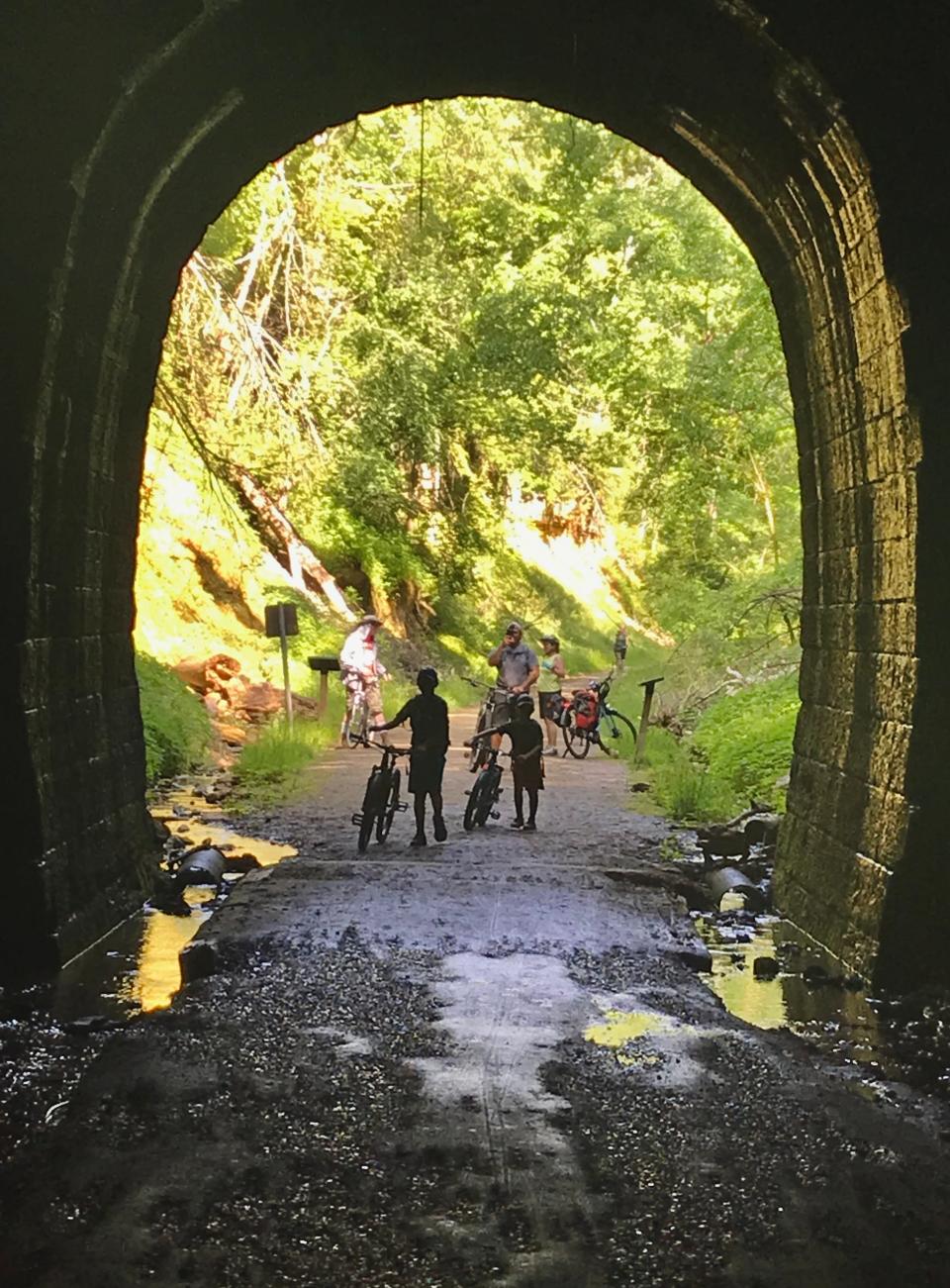
Tunnel 3 provided my headiest experience of the trip. As Sonja went ahead, I stopped near the middle and turned off my headlamp. It was like entering a waking dream. The tunnel entrances became pinholes of light at either end, and my fixed sense of up and down became slightly unmoored. In this state of suspended animation, I could feel the thick mantle of marine sandstone all around me, as if I were imbedded like a fossil beneath the floor of an ancient sea. Coming back to daylight was like returning from a different dimension.
Two more tunnels and an overnight later, we were in Elroy, where the same corridor continues as the 400 Trail, named for a North Western train that could cover the 400 miles from Chicago to the Twin Cities in 400 minutes. We had crossed the divide between the Kickapoo and Baraboo River watersheds in Tunnel 1 on the Elroy-Sparta, and the 400 Trail followed the level valley of the Baraboo all the way into Reedsburg, passing the occasional rock outcrop and pond after pond covered with green mats of duckweed.
At Reedsburg the trails ended, and we were consigned to the mercy of state and county roads for the next 60 miles. Google Maps suggests three alternative bicycle routes to Madison, but we relied on turn-by-turn instructions from the Wisconsin Department of Transportation. (Google “USBR 30.”) Our chosen route led through Baraboo, largely because it was the most convenient town for a night’s stay. A cold front came through while we were sleeping. We woke in Baraboo to temperatures near 50 and imagined we were back in Tunnel 3.
The cool was soon welcome. Shortly after leaving town, we had to climb the ancient mountains of the Baraboo Range, which proved to be the aerobic part of our day. The ascent made us lonesome for the more gradual inclines of the rail trails, but at the summit we began a long drop that we had to negotiate with both hands on our brakes. A few flat miles later, we were in Merrimac, boarding the free state ferry across the Wisconsin River. The crossing takes only seven minutes, but this functioning relic of Wisconsin’s transportation past enabled us to say that we had crossed the state by train, bike, and boat.
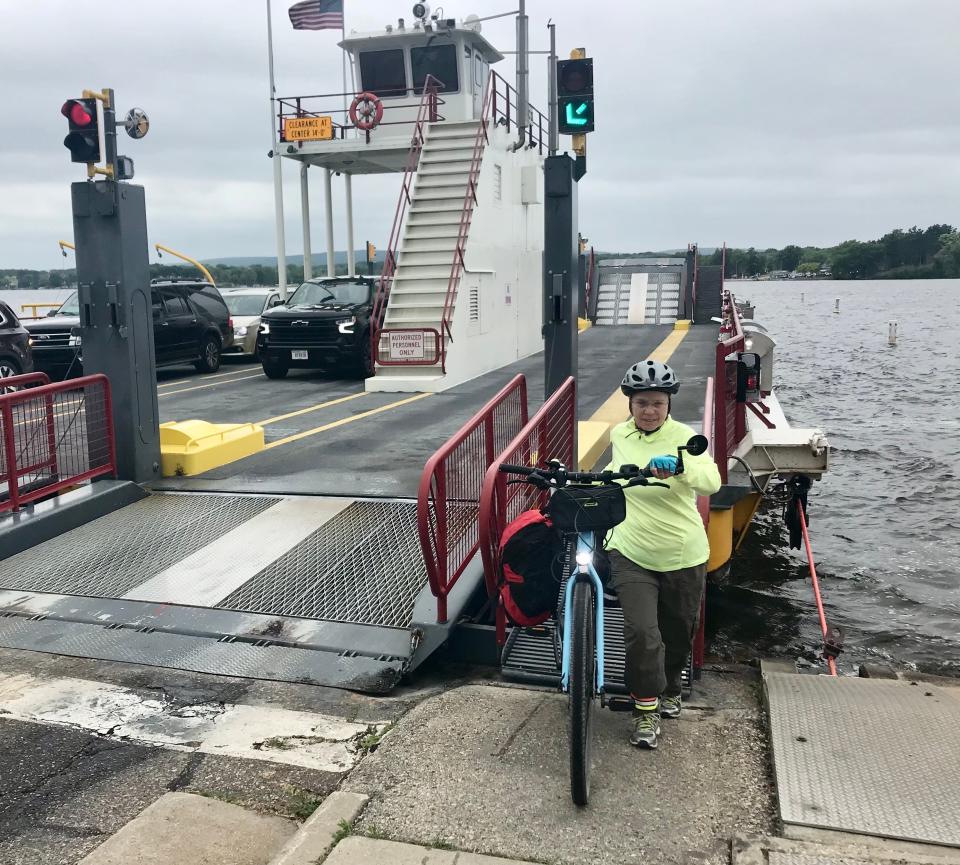
Our last leg to Madison was especially pleasant. After lunch in Lodi, a handsome town of 3,200 straddling the modest rapids of Spring Creek, we entered the broad green landscape of Columbia and northern Dane counties. The Driftless Area was behind us now. There was still plenty of relief, but the hills were tempered and tamed, smoothed by ice rather than carved by water. I don’t know whether it was the velvety new blacktop south of Lodi or the steady tailwind, but riding the 10 miles of Lodi-Springfield Road and its connectors was a particular delight. The road passes through a slice of America’s Dairyland as bucolic as any ad agency could desire, with rolling hills covered in a dozen shades of green, from the yellow tones of corn to the lime shades of wheat. At Springfield Corners we reached busy four-lane Highway 12 and a parallel bike path that took us the last few miles into Madison for the night.
Wisconsin’s capital is a famously bike-friendly city, with dedicated paths that will take you straight through town — if you have a good map and manage to avoid construction. We lacked the first and hit the second as our journey resumed, but we were still able to make it from the west side to the east in about an hour. A brief, broad-shouldered section of Highway BB took us to Cottage Grove, the start of the all-gravel Glacial Drumlin Trail and the beginning of our home stretch.
Wisconsin flattens out east of Madison. We passed dozens of drumlins — elliptical smears of glacial debris pasted onto the land by slow-moving ice — but the trail itself was nearly level, rolling past field after field and frequent patches of forest. The destination for our last night was Lake Mills, a Madison exurb that has one of the finest village greens in Wisconsin, a tree-covered triangle flanked by venerable homes and vintage storefronts.
We woke the next morning to ominous skies. The radar maps on our phones showed a curtain of rain descending on Lake Mills from the north and spreading eastward to Lake Michigan. The sightseeing was apparently over, but we still had a full day of pedaling ahead. Sonja and I were just past Jefferson when the rain started in earnest, never heavy but steady as a heartbeat. Although its timing was inconvenient for us, the rain was exactly what the land needed: a long, leisurely soak, touching every root with the promise of renewed green.
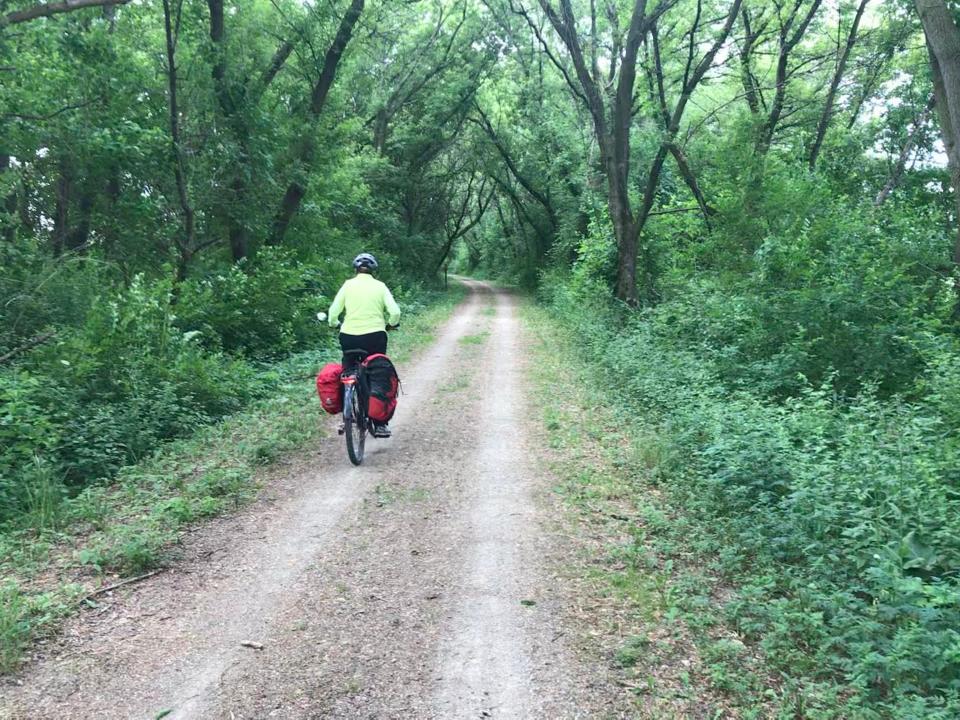
The whole region had been in the grip of drought when we started, making the trails as hard as concrete and dry as talcum powder. We ended each day with a fine layer of dust covering our bikes, our bags, and our bodies. The rain took care of that. By the time we finally reached blacktop in Dousman, the trail was turning to mush, slowing us down significantly and showing ruts wherever we passed.
We still had nearly 40 miles to go. Tiring of cold hands and wet feet, Sonja accepted the offer of two excellent friends with a bike rack, Mike and Donna Brady, to join us for lunch in Dousman and take her home. The rain continued, and so did I, knowing that the trails ahead were all paved, the grade was gradually downward, and I had a steady tailwind. It was also our last day, and I was heading toward a cold beer, a warm bath, and my own bed. Three hours out of Dousman, I was home in Bay View with a tired smile on my face.
For anyone tempted to try the coast-to-coast trip, a few suggestions from ours might be helpful. We’ve camped on earlier bike rides, but old bones need soft beds. Rather than carry a tent, bags, and cooking gear, we opted for motels and B&Bs, booking them in advance. Three stood out: Amil’s Inn near Wilton, the Fargo Mansion Inn in Lake Mills, and our daughter Kjerstin’s house in Madison, which came fully stocked with grandchildren. We also had some wonderful meals. It’s amazing how good food can taste when you’re biking 50 miles a day, and our most memorable stops included Ginny’s Cupboard in downtown Sparta, Dorset Valley Schoolhouse near Wilton (where I had a birthday slice of pecan pie on the house), and Rebel BBQ in Wonewoc.
Even with the rain, our 2023 ride was sweeter than any birthday cake. In 270 miles of pedaling, we experienced no flats, no falls, and not even a close call, but there were greater rewards. It’s a wonderfully novel feeling to come home from a five-day journey and find your car still in the garage. It was even more satisfying to experience firsthand the full breadth of my native state. From the psychedelic tunnels of the Elroy-Sparta to the heart-pounding hills of the Baraboo Range, from the cornfields of Dane County to the drumlin fields of Jefferson County, Wisconsin is a patchwork world of unusual beauty and endless variety. I’m prouder than ever to call it home.
This article originally appeared on Milwaukee Journal Sentinel: Biking from the Mississippi to Lake Michigan reveals Wisconsin's beauty

